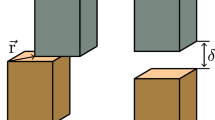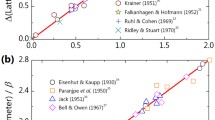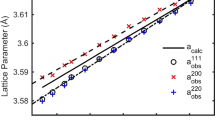Abstract
A standard technique used to determine stacking fault energies is the so-called node method in which a measurement of the curvature of partials surrounding an extended node may be related to the fault energy. A basic assumption that is made, either implicitly or explicitly, when employing this technique is that the degree of nodal extension is not influenced by precipitation or segregation effects. Clearly, if the shape or size of a node is influenced in this manner, the measured values of SFE may not be meaningful with regard to interpreting properties such as yield strength, creep behavior, susceptibility to stress-corrosion, and so forth. An example of the dramatic role that impurities can play in distorting the equilibrium dimensions of extended nodes through precipitation effects is presented in this paper.
Similar content being viewed by others
References
W. S. Williams:Trans. TMS-AIME, 1966, vol. 236, p. 211.
J. D. Venables:Phil. Mag., 1967, vol. 16, p. 873.
G. E. Hollox and R. E. Smallman:J. Appl. Phys., 1966, vol. 37, p. 818.
G. E. Hollox and R. E. Smallman:Proc. Brit. Ceram. Soc., 1964, vol. 1, p. 211.
D. A. Robins:Powder Met., 1958, vol. 1, p. 172.
R. G. Lye:Atomic and Electronic Structure of Metals, p. 99, American Society for Metals, Cleveland, 1967.
N. Thompson:Proc. Phys. Soc., 1953, vol. B66, p. 481.
A. Howie and M. J. Whelan:Proc. Roy. Soc., 1962, vol. A267, p. 206.
F. C. Frank:Defects in Crystalline Solids, p. 159, The Physical Society, London, 1955.
S. Amelinckx and W. Dekeyser:Solid State Phys., 1959, vol. 8, p. 325.
J. D. Venables:Phys. Stat. Sol., 1966, vol. 15, p. 413.
L. M. Brown:Phil. Mag., 1964, vol. 10, p. 441.
A. Howie and P. Swann:Phil. Mag., 1961, vol. 6, p. 1215.
R. L. Fleischer, P. B. Price, R. M. Walker, and E. L. Hubbard:Phys. Rev., 1964, vol. 133, p. A1443.
A. Art, R. Gevers, and S. Amelinckx:Phys. Stat. Sol., 1963, vol. 3, p. 697.
G. L. Humphrey:J. Am. Chem. Soc., 1951, vol. 73, p. 2261.
L. Kaufman and E. V. Clougherty: Report No. RTD-TDR-63-4096, Contract AF33(652)-8635, Man Labs, Inc., Cambridge, Mass., 1963, p. 290.
P. O. Schissel and O. C. Trulson:J. Phys. Chem., 1962, vol. 66, p. 1492.
Author information
Authors and Affiliations
Rights and permissions
About this article
Cite this article
Venables, J.D. Influence of impurities on stacking fault energy determination. Metall Trans 1, 2471–2476 (1970). https://doi.org/10.1007/BF03038372
Issue Date:
DOI: https://doi.org/10.1007/BF03038372




